2-for-1: Total lunar eclipse comes with supermoon bonus

The only total lunar eclipse this year and next came with a supermoon bonus.
On Sunday night, the moon, Earth and sun lined up to create the eclipse, which was visible throughout North and South America, where skies were clear. There won't be another until the year 2021.
It was also the year's first supermoon, when a full moon appears a little bigger and brighter thanks to its slightly closer position.
The entire eclipse took more than three hours. Totality—when the moon's completely bathed in Earth's shadow—lasted an hour. During a total lunar eclipse, the eclipsed, or blood, moon turns red from sunlight scattering off Earth's atmosphere.
In addition to the Americas, the entire lunar extravaganza could be observed, weather permitting, all the way across the Atlantic to parts of Europe.
-

This combination photo shows the different stages of the blood moon and supermoon during a total lunar eclipse in Los Angeles, Sunday, Jan. 20, 2019. (AP Photo/Ringo H.W. Chiu) -

In this photo made with a 12-1/2 inch telescope and provided by Johnny Horne, the totally eclipsed moon glows with a reddish color against the background stars over Stedman, N.C., Monday, Jan. 21, 2019. It was also the year's first supermoon, when a full moon appears a little bigger and brighter thanks to its slightly closer position. During totality, the moon will look red because of sunlight scattering off Earth's atmosphere. That's why an eclipsed moon is sometimes known as a blood moon. In January, the full moon is also sometimes known as the wolf moon or great spirit moon. (Johnny Horne via AP) -
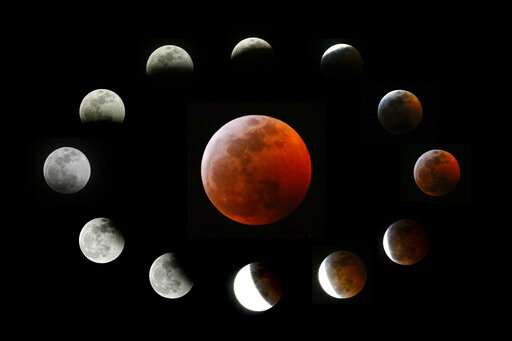
This combination photo shows the totally eclipsed moon, center, and others at the different stages during a total lunar eclipse, as seen from Los Angeles, Sunday, Jan. 20, 2019. It was also the year's first supermoon, when a full moon appears a little bigger and brighter thanks to its slightly closer position. During totality, the moon will look red because of sunlight scattering off Earth's atmosphere. That's why an eclipsed moon is sometimes known as a blood moon. In January, the full moon is also sometimes known as the wolf moon or great spirit moon. (AP Photo/Ringo H.W. Chiu) -
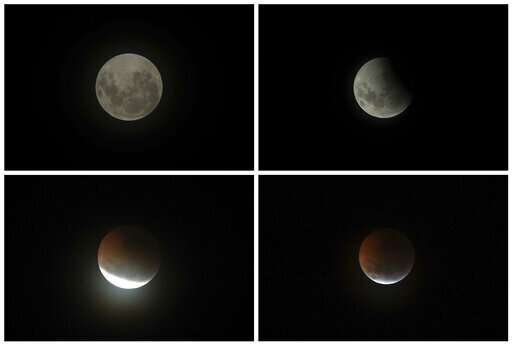
This combination photo shows the moon at the four different moments during a total lunar eclipse in Brasilia, Brazil, Monday, Jan. 21, 2019. It's also the year's first supermoon, when a full moon appears a little bigger and brighter thanks to its slightly closer position to Earth. (AP Photo/Eraldo Peres) -
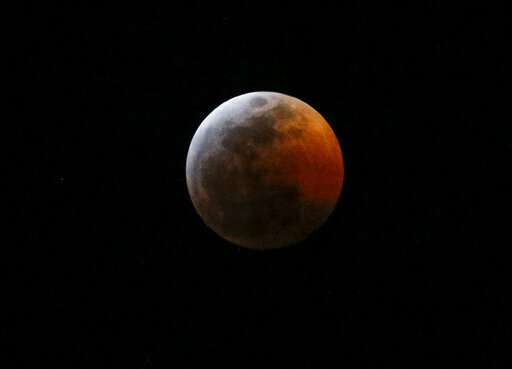
This photo shows the moon during a total lunar eclipse, seen from Los Angeles, Sunday Jan. 20, 2019. The entire eclipse will exceed three hours. Totality - when the moon's completely bathed in Earth's shadow - will last an hour. Expect the eclipsed, or blood moon, to turn red from sunlight scattering off Earth's atmosphere. (AP Photo/Ringo H.W. Chiu) -
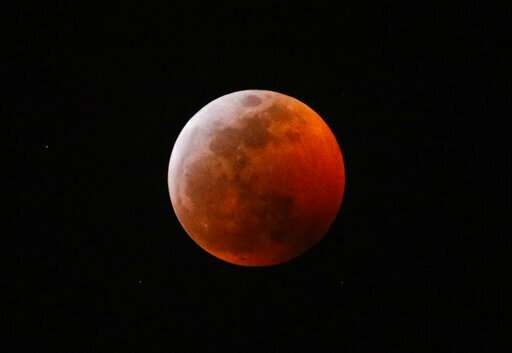
This photo shows the moon during a total lunar eclipse, seen from Los Angeles, Sunday Jan. 20, 2019. The entire eclipse will exceed three hours. Totality - when the moon's completely bathed in Earth's shadow - will last an hour. Expect the eclipsed, or blood moon, to turn red from sunlight scattering off Earth's atmosphere. (AP Photo/Ringo H.W. Chiu) -
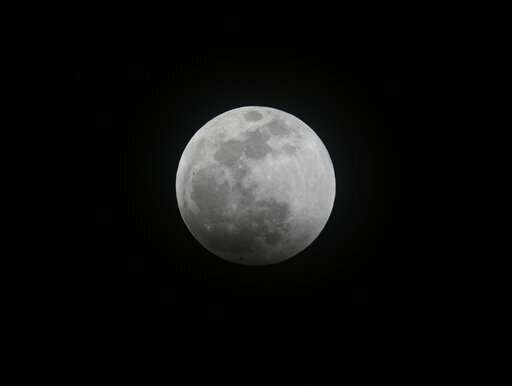
A supermoon is seen in Los Angeles, Sunday, Jan. 20, 2019. The year's first supermoon, when a full moon appears a little bigger and brighter thanks to its slightly closer position to Earth, is one of two lunar events Sunday. If skies are clear, a total eclipse will also be visible in North and South America, and parts of Europe. (AP Photo/Ringo H.W. Chiu) -

A lunar eclipse progresses behind the "Monumento a la Carta Magna y Las Cuatro Regiones Argentinas" in Buenos Aires, Argentina, Monday, Jan. 21, 2019. It's also the year's first supermoon, when a full moon appears a little bigger and brighter thanks to its slightly closer position to Earth. (AP Photo/Natacha Pisarenko) -
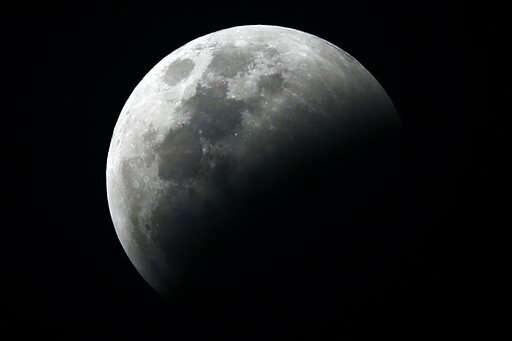
The moon is seen partially covered during a lunar eclipse seen in the sky over Ciudad Hidalgo, Chiapas state, Mexico, Sunday, Jan. 20, 2019. The entire eclipse will exceed three hours. Totality - when the moon's completely bathed in Earth's shadow - will last an hour. Expect the eclipsed, or blood moon, to turn red from sunlight scattering off Earth's atmosphere. (AP Photo Marco Ugarte) -
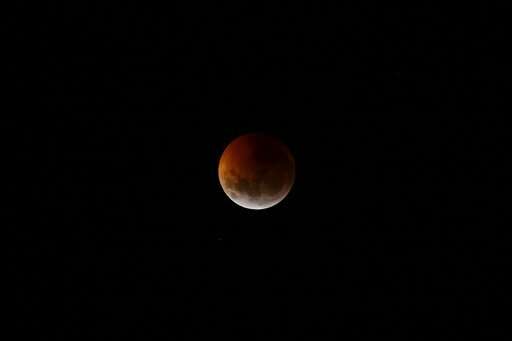
This photo shows the moon partially covered during a total lunar eclipse seen over Asuncion, Paraguay, Monday, Jan. 21, 2019. The entire eclipse will exceed three hours. Totality - when the moon's completely bathed in Earth's shadow - will last an hour. Expect the eclipsed, or blood moon, to turn red from sunlight scattering off Earth's atmosphere. (AP Photo/Jorge Saenz) -
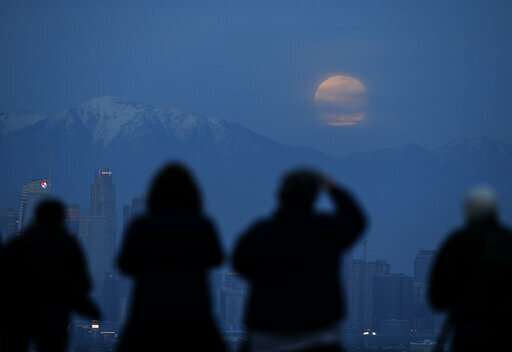
People watch the supermoon rise behind the downtown Los Angeles skyline, from Kenneth Hahn Park in Los Angeles, Sunday, Jan. 20, 2019. The year's first supermoon, when a full moon appears a little bigger and brighter thanks to its slightly closer position to Earth, is one of two lunar events Sunday. If skies are clear, a total eclipse will also be visible in North and South America, and parts of Europe. (AP Photo/Ringo H.W. Chiu) -
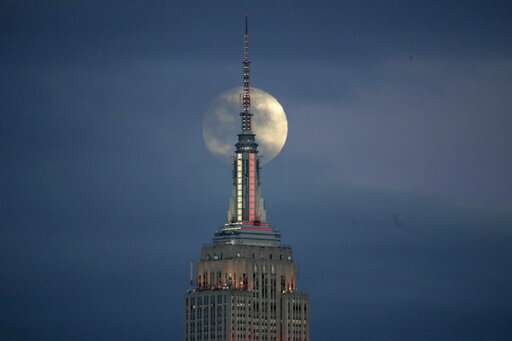
The moon is seen in its waxing gibbous stage as it rises behind the Empire State Building, Sunday, Jan. 20, 2019, seen from Jersey City, N.J. The moon will experience a lunar eclipse, when the earth moves directly between the sun and the moon, and will be seen across the United States late Sunday night. (AP Photo/Julio Cortez) -
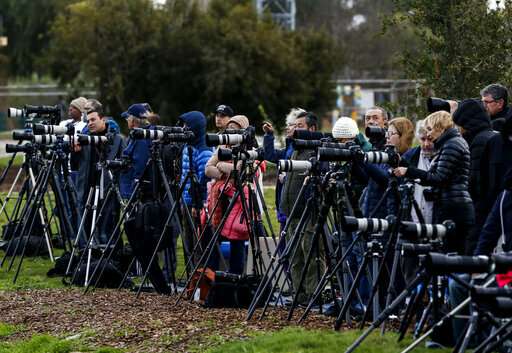
Photographers stage at Kenneth Hahn Park in Los Angeles as they wait to capture the supermoon, Sunday, Jan. 20, 2019. The year's first supermoon, when a full moon appears a little bigger and brighter thanks to its slightly closer position to Earth, is one of two lunar events Sunday. If skies are clear, a total eclipse will also be visible in North and South America, and parts of Europe. (AP Photo/Ringo H.W. Chiu)
© 2019 The Associated Press. All rights reserved.





















